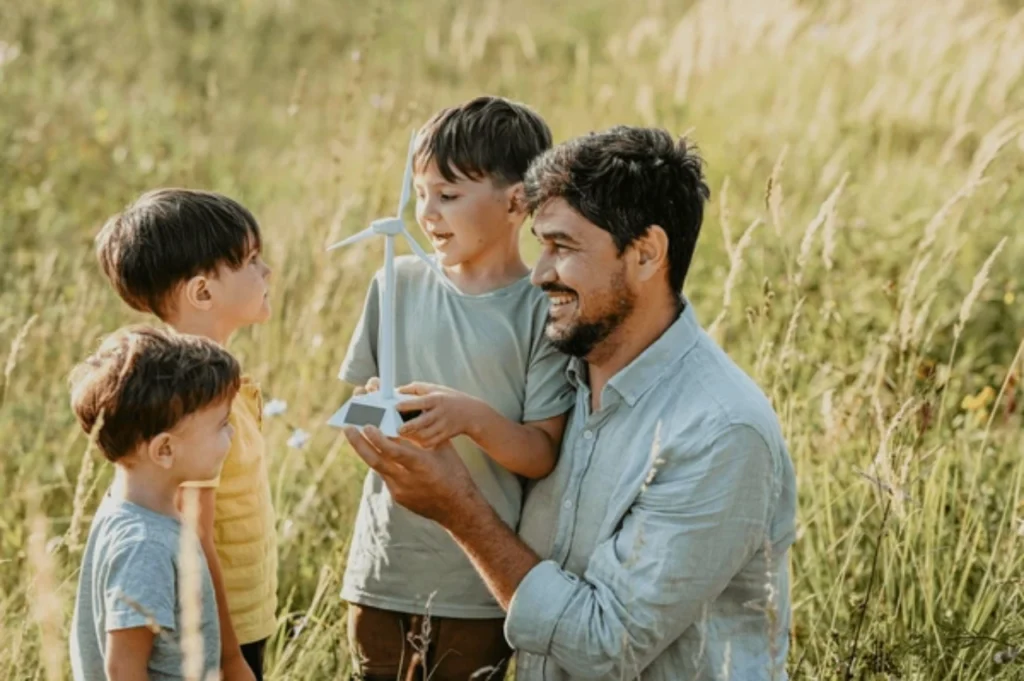Empathy is key for building strong relationships and success. As parents, we can help our kids grow in this area. By using different strategies, we can make our kids more caring and emotionally smart1.
We’ll look at five ways to teach empathy, like showing empathy ourselves and using stories and hands-on activities. Remember, teaching empathy takes time, patience, and knowing your child well2.
With the right steps, you can help your child become more compassionate and emotionally aware. This will help them make deep connections with others and have a happy, successful life3.
Key Takeaways:
- Empathy is a crucial skill that can be taught and developed in children.
- Modeling empathetic behavior is a powerful way to teach empathy to kids.
- Discussing emotions openly and helping others can foster empathy in children.
- Praising empathetic behavior reinforces the development of this essential skill.
- Age-specific strategies, such as labeling emotions and teaching healthy boundaries, are important in teaching empathy.
Understanding Empathy: The Foundation of Emotional Intelligence
Empathy is key to emotional intelligence. It lets us see and feel emotions in ourselves and others. There are three types: cognitive, emotional, and compassionate empathy.
Different Types of Empathy
Cognitive empathy helps us understand others’ feelings and why they feel that way. Emotional empathy lets us feel what others feel, creating deeper connections. Compassionate empathy motivates us to help others.
Why Emotional Intelligence Matters
Emotional intelligence is vital for dealing with people and relationships. Empathetic kids resist peer pressure4 and are less aggressive4. They also communicate better and form strong bonds4. It’s the base for good relationships and success in adulthood.
Studies show empathy can be taught early5. Teaching empathy in schools boosts social and emotional skills5. Showing empathy and encouraging it in kids greatly helps them understand and practice it5.
“Empathy is about standing in someone else’s shoes, feeling with his or her heart, seeing with his or her eyes.”
– Daniel H. Pink
By growing empathy, we help kids develop emotional smarts. This way, they can handle life’s challenges, form strong bonds, and positively impact the world.
The Science Behind Empathy Development in Children
Empathy in children comes from both their genes and their environment. About 20% of people are naturally more empathetic6. For others, empathy can grow with practice and exposure. Studies show that empathetic people use more brain areas linked to feeling others’ emotions6.
How well children understand others’ feelings changes over time6. Even babies show they care when they see others upset, thanks to special brain cells called mirror neurons6. The bond between a child and their caregivers greatly influences their ability to empathize later on6.
By age six or seven, kids can see things from another’s point of view and help when needed6. As they grow, they learn to imagine how others feel and care about their happiness6.
Many things affect how empathetic children become, like their genes, personality, and surroundings6. The Greater Good Science Center says empathy is key to being moral, helping others, and showing kindness7.
| Empathy Components | Description |
|---|---|
| Emotional Empathy | Feeling the same emotion as another person, personal distress, and feeling compassion for another person7. |
| Cognitive Empathy | Perceiving and understanding the emotions of another individual accurately, indicating an ability to recognize and understand others’ emotional states7. |
Empathy starts to grow in the second and third years of life, seen in how kids interact with others7. Even babies as young as 12 months can comfort someone who is upset7.
Evolution might have made empathy important for parents to care for their young, helping them survive and thrive7. Without empathy, we might see problems like not caring about others, showing how vital it is for good relationships7.
Being very empathetic can lead to having more friends and happier relationships7.
Recognizing Emotions: A Key Step in Teaching Empathy

Teaching children to understand emotions is key to empathy. They learn to read faces, understand body language, and spot emotional triggers8. This helps them develop real empathy and kindness.
Reading Facial Expressions
Facial expressions show how someone feels. Games like emotion charades and using pictures to talk about feelings help kids get it. Watching people in public and talking about their body also helps.
Understanding Body Language
Body language, like how someone stands or talks, tells a lot. Encouraging kids to notice and understand these signs helps them feel more empathy. This is true for people they see in books or TV too.
Identifying Emotional Triggers
Knowing what makes you feel certain ways is important for empathy. Helping kids see what makes them feel certain emotions helps them understand others better8. This self-awareness is the first step to being kind and supportive.
Teaching empathy helps kids do better in school and get along better with others8. By teaching them to notice and understand emotions, we help them grow into empathetic and emotionally smart people.
| Empathy Type | Definition |
|---|---|
| Affective Empathy | The ability to feel and share the emotions of others. |
| Cognitive Empathy | The ability to understand and comprehend the perspective of another person. |
| Compassionate Empathy | The ability to feel and act with concern for the well-being of others. |
Some students find it hard to connect with others. Empathy education can help8. By teaching them to notice and understand emotions, teachers can create a kinder classroom.
“Empathy is about standing in someone else’s shoes, feeling with his or her heart, seeing with his or her eyes. Not only is empathy hard to come by, but it’s in steep decline in our culture.”
– Roman Krznaric, author of “Empathy: Why It Matters, and How to Get It”
Teaching kids to recognize emotions is key to empathy. By teaching them to read faces, understand body language, and spot emotional triggers, we prepare them for the world89.
The Role of Parents in Modeling Empathetic Behavior

As parents, our actions greatly shape our children’s empathy skills. Parental influence and role modeling are key in teaching empathy skills to young ones10. Studies reveal that an authoritative parenting style boosts empathy in kids10. Parents who are warm, reason with their children, and are involved see their kids grow more empathetic10.
Parents must show empathy by being kind and understanding. This means caring for others and showing concern for those facing hard times11. When kids learn to empathize, they build stronger relationships with friends and family11. Teaching empathy early helps kids develop emotional intelligence for a better world11.
- Parents should prioritize caring for others and set high ethical expectations.
- It’s important to send clear messages about the importance of kindness and help children understand that the world doesn’t revolve around them.
- Parental warmth and reasoning are important factors in modeling affective and cognitive empathy in children10.
Children learn best by watching and doing. By showing empathy, we encourage our kids to grow in compassion and emotional smarts1011.
“Empathy is not just listening, it’s asking the questions whose answers need to be listened to.”
– Winnie Mandela
Creating a Safe Space for Emotional Expression
Teaching empathy to children starts with emotional safety. It means supporting their feelings and teaching them to handle tough emotions12. Parents can do this by talking openly and accepting their kids’ feelings. This makes a safe place where kids can share without fear.
Supporting Emotional Vulnerability
It’s important to let kids be open about their feelings12. When parents show kindness and understanding, it builds trust. This trust helps kids feel safe to share more, improving their relationship with parents.
Managing Difficult Emotions
Feeling sad, angry, or frustrated is normal13. Parents should help kids deal with these feelings in a good way. They can teach coping skills, listen, and show how to manage emotions.
| Strategies for Managing Difficult Emotions | Benefits |
|---|---|
|
|
By making a safe space for feelings and supporting vulnerability, parents help grow empathy121413.
Teaching Empathy Through Storytelling and Books
Storytelling and children’s books are great ways to teach empathy. When parents read with their kids, they can talk about characters’ feelings and different views. Books like “Listening with My Heart” by Gabi Garcia, “Chrysanthemum” by Kevin Henkes, and “The Day the Crayons Quit” by Drew Daywalt help kids understand many feelings and experiences15.
Parents can ask questions about characters’ feelings and why they feel that way. This helps kids see things from different angles and understand empathy better15. It also helps them learn more about emotions and feel safe and secure, which are key for empathy15.
- Children’s books let kids see different views and experiences. They learn about cooperation, selfishness, problem-solving, and meeting people unlike themselves15.
- Choosing good children’s books with real characters can help a child’s empathy grow15.
- Reading books slowly and talking about characters’ feelings helps kids learn to identify emotions. This is a big step in empathy15.
- Reading favorite books again helps kids understand and connect with stories more. This boosts their empathy15.
- Talking about favorite books and how they relate to personal experiences or stories can improve empathy in kids15.
The Growing Readers program at Bright Horizons suggests great children’s books. These books make reading fun, build a love for stories, and help with early reading skills. All these things help kids develop empathy15.
| Age Range | Number of Books | Topics Covered |
|---|---|---|
| 3 – 5, 3 – 7, 4 – 8, 5 – 816 | 1416 | empathy, compassion, kindness, inclusion, grief, perspective, imagination, bullying, injustice, courage, friendship, acceptance, support, understanding, language barriers, refugee experiences, care for friends, differences, forgiveness, apologies, inclusion, making a difference, kindness as a choice, and kindness impact on the world16. |
By using stories and quality children’s books in family life, parents can help kids grow in empathy, emotional smarts, and understanding of different views15.
The Power of Active Listening in Building Empathy
Effective communication is key to building empathy. Active listening means fully focusing on what someone says17. It’s important for better relationships and learning18.
Effective Communication Techniques
Active listening takes effort and practice17. It includes eye contact, nods, and clear questions17. These actions show you care and encourage open talk.
Validating Feelings
Empathy is more than understanding; it’s about validating feelings17. Reflecting what you heard and showing concern helps17. It makes people feel heard and supported.
Active listening and empathy together, called empathetic listening, strengthens bonds17. It makes people feel respected and more open to share18.
| Active Listening Techniques | Benefits of Empathetic Listening |
|---|---|
|
|
Using active listening and empathy in talks can make connections stronger18. It helps everyone feel understood and confident to share18.
“Empathy is about listening, holding space, connecting emotionally, and communicating the message of ‘You’re not alone.'”17 – Brene Brown, author of “Daring Greatly”
Using Play and Games to Develop Empathy Skills
Teaching children to be empathetic is key for their growth. Play and games are great tools for this. Activities like emotion charades and role-playing help kids understand and respond to feelings. They offer a safe space to explore different views19.
Games like “Empathy Map” and those based on “Inside Out” make learning fun. They help kids identify their feelings and understand others’. This makes learning about emotions engaging and enjoyable19.
- Newborn babies can show empathy by reacting to another baby’s cry19.
- Toddlers can show empathy through facial expressions and hugs19.
- Learning empathy builds secure relationships and acceptance19.
- Empathy helps kids understand themselves and others19.
- Empathy is linked to better mental health and happiness19.
- Even young children can show empathy by comforting others19.
- Activities like drawing emotions help kids aged 4 and up practice empathy19.
Activities like the “golden rule” and role-playing are great for building empathy. They are suitable for kids aged 4 and up19.
Play-based activities improve empathy and social skills. They also boost emotional intelligence. By using these fun methods, parents and teachers can help children grow in empathy. This prepares them for better relationships and well-being20.
Building Bridges: Teaching Empathy Across Cultural Differences
In today’s world, teaching kids to understand different cultures is key. By celebrating diversity and learning about various perspectives, we prepare them for a global community. Knowing about different cultures helps them grasp norms, values, and traditions21.
Celebrating Diversity
Exposing kids to diverse peers can widen their empathy. Empathy is a skill that grows in schools and communities22. Reading books with diverse characters and talking about cultural differences helps them see the value of diversity.
Understanding Different Perspectives
- Encourage kids to listen to and consider different cultural views23.
- Get them involved in talks about diverse experiences and their impact23.
- Create a classroom that celebrates diversity and promotes understanding23.
Teaching kids to empathize with others from different cultures prepares them for a global world. It helps them build strong connections. Learning about cultures makes teamwork and international business better, leading to respectful interactions21.
| Skill | Importance | Application |
|---|---|---|
| Cultural Empathy | Creates harmony, improves mental health, and boosts belonging21. | Crucial for caring medical services, respectful interactions, and teamwork in global business21. |
| Empathy | Builds loyalty, raises morale, and fosters team spirit22. | Key for teamwork, solving conflicts, and leadership in many settings23. |
By teaching empathy and perspective-taking, we prepare our kids for a diverse world.
Real-World Practice: Community Service and Helping Others
Doing community service and helping others is a great way to practice empathy. You can volunteer at local groups or do small acts of kindness every day. This approach, called “doing with” others, helps build connections across different groups24.
Community service helps kids see different life experiences and challenges. It broadens their view and makes them more empathetic.
Volunteering has many benefits beyond just helping others25. A study found that those who volunteer monthly are 7% happier than those who don’t. Those who volunteer every two to four weeks are 12% happier. And weekly volunteers are 16% happier25.
Volunteering can also improve your health. It can lower symptoms of chronic pain or heart disease. Older adults who volunteer live longer than those who don’t.
There are many ways to help out, from simple acts to more structured volunteer work26. 5K races are a fun way to support local causes. They’re a great choice for community service26.
There are 30 ways to get your family involved in helping others, from planting trees to making care packages26. You can do simple things like picking up trash or read to kids in shelters. Or, you can visit retirement homes.
It’s important to involve family and friends in charity work. It makes the service more meaningful and valuable26. Helping others together strengthens bonds and shows empathy in action.
| Benefits of Volunteering | Key Findings |
|---|---|
| Happiness | Volunteers report being “very happy” 7-16% more often than non-volunteers25. |
| Health | Volunteering can decrease symptoms of chronic pain or heart disease and lower mortality rates for older adults25. |
| Personal Growth | Volunteering can improve self-confidence, self-esteem, and overall life satisfaction25. |
| Skill Development | Volunteering helps individuals develop important job skills such as teamwork, communication, problem-solving, and organization25. |
| Social Benefits | Volunteering allows individuals to practice and develop social skills, as well as expand their networking opportunities25. |
| Positive Outlook | Engaging in volunteer work provides a sense of accomplishment and pride, leading to a more positive outlook on life and future goals25. |
“Volunteering allows individuals to practice and develop social skills, as well as expand their networking opportunities.”25
By doing community service, kids learn about empathy and its value. These experiences help both the giver and receiver. They promote personal growth, social connections, and a sense of purpose.
Remember, community service, altruism, and empathy in action are key to raising empathetic kids. Taking part in these activities can shape a more caring and connected generation.
Teaching Empathy Through Conflict Resolution
Teaching empathy through conflict resolution is very important. When conflicts happen, ask your kids to think about the other person’s feelings. Ask them, “How do you think they’re feeling?” and “What does this situation look like from their point of view?”27 This helps them see things from different angles, which is key to emotional intelligence.
Learning to solve conflicts with empathy can make relationships better. It also helps them solve problems more effectively27. By practicing empathy every day, kids can build stronger relationships and solve problems better27.
- Encourage active listening and validating feelings during conflicts.
- Teach them to express feelings in a good way, like using “I” statements.
- Show them how to say sorry and take responsibility for their actions.
- Help them work together to find solutions.
- Be proud of them when they solve conflicts well and grow in empathy.
By teaching empathy through conflict resolution, you help your kids and teens grow emotionally. This way, they can understand and work with others better28. Empathy helps stop blame and victimhood by letting people see and feel others’ feelings28.
| Skill | Description |
|---|---|
| Active Listening | Focusing on understanding the other person’s perspective, not just formulating a response. |
| Emotion Regulation | Managing one’s own emotions to respond calmly and thoughtfully during conflicts. |
| Collaboration | Working together to find mutually agreeable solutions, rather than competing or dominating. |
By showing empathy and teaching these skills, you empower your kids and teens. They can handle conflicts better, solve problems more effectively, and build stronger relationships2827.
Digital Age Challenges in Teaching Empathy
In today’s digital world, teaching empathy to kids is tough for parents. It’s important to balance screen time with face-to-face talks. Parents need to teach kids to be kind and respectful online29.
Online, kids might act mean without knowing it. So, teaching empathy in all interactions is key. Parents should talk about how social media affects feelings29.
Screen Time Balance
Finding the right mix of digital and real-life experiences is crucial. Too much screen time can hurt kids’ social skills. Parents should watch how much time kids spend online and make sure they interact face-to-face29.
Online Interaction Guidelines
Parents should set rules for online behavior. These rules should teach kids to be kind and respectful, even online. This way, kids learn to be empathetic in both the digital and real worlds29.
The digital age brings both chances and challenges for teaching empathy. By balancing screen time and real-life experiences, parents can help kids grow emotionally. This way, kids can do well in today’s world29.
| Benefits of Technology in Education | Strategies for Developing Empathy |
|---|---|
|
“The rise of personal tech and media has made empathy harder, affecting how we interact online.”29
Finding a balance between tech and empathy is key in today’s world. By setting rules, controlling screen time, and teaching kindness online, parents can help kids grow emotionally. This way, kids can succeed in our modern world29.
Age-Appropriate Strategies for Teaching Empathy
Empathy grows in children as they get older. It’s key to teach empathy in ways that match their age31.
For kids aged 3-5, start by naming feelings and telling simple stories about them32. Play games like emotion charades or read books that show different feelings. Use pictures of faces to help them see how others feel32.
When kids are 5-7, play more complex games that help them understand emotions better32. Talk about what might happen in different situations. Teach them to notice how people feel without words and to respect others’ space32.
As kids get older, teach them about cultural empathy and seeing things from different views32. Show them people from various backgrounds. This helps them understand and value differences32.
Remember, teaching empathy takes time and grows with your child31. Change your teaching methods as your child grows. Make sure what you do fits their age and needs32.
| Age Range | Empathy Teaching Strategies |
|---|---|
| 3-5 years |
|
| 5-7 years |
|
By using empathy education methods that fit each child development stage, you can help your kids grow in empathy and emotional smarts313233.
Common Obstacles in Empathy Development
Teaching empathy to kids is rewarding but tough. Empathy challenges, emotional barriers, and parenting difficulties can block this important skill. Knowing these obstacles helps us overcome them and teach our kids to care and understand others better.
Parental stress and emotional health are big hurdles. When parents are stressed, teaching empathy is harder34. Also, some kids naturally get empathy more than others35.
Our society’s focus on self over others also hinders empathy. We need to make a conscious effort to teach kids to care for others34. Some kids find it hard to understand and share others’ feelings35.
To beat these challenges, we need patience, persistence, and flexibility. Seeing empathy growth as a long-term effort helps us keep going, even when it’s tough34. By showing empathy ourselves, creating a safe space for feelings, and using tools like stories and community service, we can help kids break down emotional barriers and understand others better36.
The path to empathy is filled with obstacles, but the benefits of raising caring, smart kids are worth it. By facing and solving parenting difficulties, we guide our kids through the emotional world and help them grow into empathetic, well-rounded people.
Measuring Progress: Signs of Empathy Growth
As you help your child grow in empathy, it’s key to see the signs of progress. Look for times when your child shows increased awareness of others’ feelings37. Also, watch for when they display more compassion37 and get better at solving conflicts37. These small wins show your child’s emotional growth and your teaching’s success.
Empathy growth takes time, and every step is worth celebrating. Adding empathy goals to IEPs helps focus on empathy in school37. This way, you can see how your child is doing and where they need more help.
Teaching empathy helps kids talk better, solve problems, and make strong friendships37. By checking in on your child’s empathy, you can tweak your teaching to keep them growing.
The path to growing empathy isn’t always smooth. Your child might hit bumps, but with your help, they can get through them. Be patient, celebrate the small wins, and know your hard work will pay off in their emotional and social growth.
Remember, keeping an eye on how students grow in empathy is key to spotting areas to improve and adjusting IEP goals37. By paying close attention to your child’s emotional journey, you help them develop the empathy, emotional growth, and social skills progress they need to succeed3738.
Conclusion
Teaching empathy to kids is key in parenting. It helps them grow emotionally and succeed in life. By showing empathy ourselves, giving them chances to practice, and helping them through tough times, we help them develop this important skill. Social Emotional Learning (SEL) helps students develop social and emotional skills. Empathy is a big part of SEL, helping kids get along better, feel part of a group, and be kind and open-minded39.
Teaching empathy takes time, patience, and being flexible. The hard work pays off when kids have better relationships, feel emotionally strong, and can handle the world’s challenges. Studies show teaching empathy to young kids helps them get along better and cuts down on bullying40. By helping teachers learn empathy too, we can make sure kids learn it well40.
As parents, we can shape the future by teaching emotional intelligence and empathy. By practicing empathy, talking openly, and creating a supportive space, we help our kids grow into caring, strong, and socially smart people. They’ll be ready to face the world’s problems3940.
FAQ
What are the different types of empathy?
Why is emotional intelligence important for children?
How does brain research show that some people are more naturally empathetic?
What are some effective strategies for teaching children to recognize emotions?
How can parents model empathetic behavior for their children?
Why is creating a safe space for emotional expression important for empathy development?
How can stories and books be used to teach empathy?
What are some effective active listening techniques for building empathy?
How can play and games be used to develop empathy skills in children?
Why is teaching empathy across cultural differences important?
How can community service and helping others foster empathy development?
How can teaching empathetic conflict resolution skills benefit children?
What are some of the challenges in teaching empathy in the digital age?
How should empathy teaching strategies be tailored to different developmental stages?
What are some common obstacles in empathy development, and how can parents overcome them?
How can parents recognize signs of empathy growth in their children?
Source Links
- Key Strategies to Teach Children Empathy (Sorted by Age)
- How To Teach Empathy To Your Child in Five Ways
- 5 Strategies to Teach Your Children Empathy | Aurrum Kids
- Nurturing Empathy in Children: The Foundation of Emotional Intelligence — Doing Good Together™
- The Role of Empathy in Social Emotional Learning: Building Emotional Intelligence | Everyday Speech
- How Children Develop Empathy
- The Psychology of Emotional and Cognitive Empathy
- 6 Steps To Cultivate Greater Empathy in Teaching
- Nine Competencies for Teaching Empathy
- The Influence of Parenting and Temperament on Empathy Development in Toddlers
- Teaching Empathy for Kids So They Hone The Skill While They’re Young – Kong Academy | Empowering Kids Through Play
- How to Establish a Safe Space for Teen Emotional Expression?
- Emotional Safety | National Center on Safe Supportive Learning Environments (NCSSLE)
- Creating Spaces for Empathy in Every Conversation
- Using Children’s Books to Teach Empathy
- 15 Books That Model Empathy and Compassion for Young Readers
- Active listening and empathy for human connection
- How Active Listening In The Classroom Develops Empathy – XQ
- 25 Best Empathy Activities for Kids
- Empathy Activities for Kind and Not-Bored Kids
- Cultural Competency: Building Bridges Across Differences
- Empathy: The Invisible Superpower for Building Bridges and Changing Lives
- Building Bridges: Teaching Empathy to Elementary Students for Positive Relationships | Everyday Speech
- How to Build Empathy and Strengthen Your School Community — Making Caring Common
- Benefits of Community Service – Community Engagement
- Community Service Ideas for Kids & Families | Children’s Bureau
- Teaching Empathy: Understanding Different Thoughts and Feelings | Everyday Speech
- From Blame To Empathy: Lessons For Leaders To Diffuse Conflict
- The Emerging Issue of Digital Empathy
- Harnessing Technology for Connection and Understanding – The Hub
- How to Help Your Child Develop Empathy
- Key Strategies to Teach Children Empathy (Sorted by Age)
- Teaching empathy: Evidence-based tips
- 4 Proven Strategies for Teaching Empathy
- The typical and atypical development of empathy: How big is the gap from lab to field?
- Understanding Empathy Development Stages So You Know How Your Kids Are Doing – Kong Academy | Empowering Kids Through Play
- Empathy Development through IEP Goals: Building Emotional Understanding in Students | Everyday Speech
- Nurturing Empathy in Middle School: Strategies for Teachers | Everyday Speech
- The Importance of Teaching Empathy: Exploring the Benefits of an Empathy Curriculum | Everyday Speech
- The Importance of Teaching Empathy: Strategies for Elementary Students | Everyday Speech





